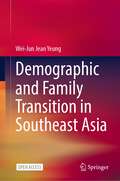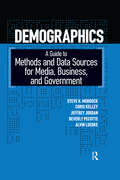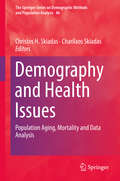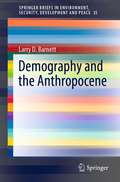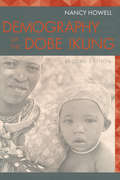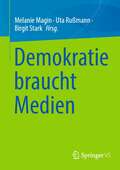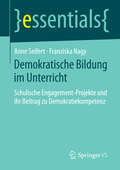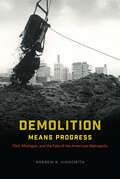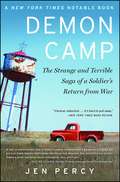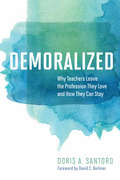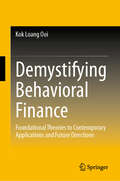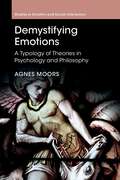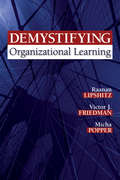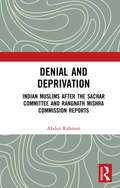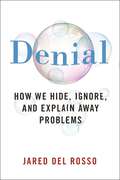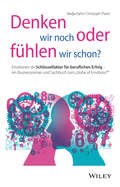- Table View
- List View
Demographic and Family Transition in Southeast Asia
by Wei-Jun Jean YeungThis open access book presents the trends and patterns of demographic and family changes from all eleven countries in the region for the past 50 years. The rich data are coupled with historical, cultural and policy background to facilitate an understanding of the changes that families in Southeast Asia have been going through. The book is structured into two parts. Part A includes three segments preceded by a briefing on Southeast Asia. The first segment focuses on marital and partnership status in the region, particularly marriage rates, age at marriage, incidence of singlehood, cohabitation, and divorce. The second segment focuses on fertility indicators such as fertility rates (total, age-specific, adolescent), age at childbearing, and childlessness. The third presents information on household structures in the region by examining household sizes, and incidence of one-person households, single-parent families, as well as extended and composite households. Part B presents indicators of children and youth’s well-being.
Demographics: A Guide to Methods and Data Sources for Media, Business, and Government
by Beverly Pecotte Steven H. Murdock Chris Kelley Jeffrey L. Jordan Alvin LuedkeDemographics has become a critical dimension of the work of many journalists, business professionals, and government analysts and managers. Yet those who are not professional demographers often find locating and effectively using demographics difficult. Written by leading authorities, Demographics provides a single-volume resource that is readily understandable by everyone. It describes and demonstrates how students and working professionals can obtain, use, and communicate demographic information effectively. Consisting of ten chapters organized into four sections on basic demographic concepts, definitions, and methods, this book includes sources of demographic and economic data as well as explanations and examples of how to effectively and accurately use them.
Demography and Health Issues: Population Aging, Mortality And Data Analysis (The\springer Series On Demographic Methods And Population Analysis Ser. #46)
by Christos H. Skiadas Charilaos SkiadasThis book provides new theories, applications and quantitative methods in demography, population studies and statistics. It presents and applies data analysis, statistics and stochastic modeling techniques focusing on demography, population aging, mortality and health sciences. The book describes diverse stochastic processes as well as Markov and semi-Markov models in demography and population studies, along with chapters on statistical models and methods in biostatistics and epidemiology. As such the book will be a valuable source to demographers, health scientists, statisticians, economists and sociologists.
Demography and the Anthropocene (SpringerBriefs in Environment, Security, Development and Peace #35)
by Larry D. BarnettEnvironmentalists devote little attention at the moment to the size and growth of the human population. To counter this neglect, the monograph (i) includes original graphs showing population size and growth since 1920 in the world as a whole and the United States; (ii) assembles evidence tying the increasing number of people to ecosystem deterioration and its societal consequences; and (iii) analyzes sample-survey data to ascertain whether the current disregard of population pressures by U.S. environmentalists reflects the thinking of Americans generally. However, even if a nation took steps primarily intended to lower childbearing and immigration, the findings of social science research indicate that the steps would not have a substantial, lasting impact. The discussion, which suggests an indirect way by which government may reduce fertility, underlines for environmental scholars the importance of studying their subject in a multidisciplinary, collaborative setting.
Demography of the Dobe !Kung
by Robert GutmanFirst published in 1979, this is a classic study of the population of the Bushmen of the Kalahari Deselt of Botswana. Using methods that are simple and fully illustrated, the author presents empirical descriptions of the fertility, mortality, and marriage patterns of the now famous !Kung hunter-gatherers.The !King "Bushman" people of the Kalahari desert in Africa occupy an anomalous position in the world of science. They have been selected for intensive study precisely because they are geographically, socially, and economically removed from modern, industrialized society, living in a sparsely settled and remote portion of an enormous semidesert. The !Kung maintain the language and culture of a fully develop hunting and gathering society with (until very recently) no dependence on cultivated plants, no domesticated animals other than the dog, no stratification system based on kinship or occupation, no power or authority structure extending further than the local bands composed of a few related families, no wage labor, no use of money, and no settled sites of occupation.At the same time, the !Kung have become well-known figures to students—both undergraduate and professional—of Western social science. The faces of !Kung informants gaze from the covers and the illustrations of many texts in anthropology and sociology.Why has all this attention been developed around the !Kung people? Part of the answer lies in the people themselves. The !Kung are a physically attractive people, with slender, graceful bodies and open small-featured faces that are appealing and photogenic. Their culture is simple and has its striking features. The struggle for subsistence, the click language, the emphasis on sharing and humility, the drama of the curing dances in which individuals go into trance and speak directly to spirits to cure sickness, and the pervasive humor, teasing, and playfulness of the !Kung style are all features that are relatively easy to convey and interesting to l earn about.This work covers areas such as marriage, fertility, disease, mortality, history, and the projected future of the !Kung. This book will be of interest to students of demographic studies, anthropology, and African studies.
Demokratie braucht Medien
by Uta Rußmann Melanie Magin Birgit StarkFreie und unabhängige Medien sind die Grundlage einer lebendigen Demokratie. In normativen Demokratiemodellen wird die „Wächterrolle“ von Medien betont, weil neben der Kontroll- und Informationsfunktion der Medien ihr Beitrag zur Legitimierung politischer Prozesse als zentral angesehen wird. Medien unterliegen jedoch im digitalen Wandel einem hohen Anpassungsdruck: Sie drohen ihre traditionelle Gatekeeper-Rolle zu verlieren und konkurrieren mit globalen Tech-Giganten wie Facebook und Google um Werbegelder und die Aufmerksamkeit des Publikums. Die Plattformisierung der Medien stellt nicht nur die Vermittlungsleistungen professioneller journalistischer Informationsanbieter in Frage, sondern auch die Rolle der Medien in der Herstellung von Öffentlichkeit. Der Band hinterfragt die sich wandelnde Rolle der Medien im politischen System sowie das Verhältnis von Medien und Politik kritisch. Funktionen und Autonomiegrad von Medien und Journalismus werden analysiert. Mithilfe von Zeitvergleichen werden tiefgreifende Veränderungen wie auch Konstanten herausgearbeitet. Nicht zuletzt gilt es zu erörtern, welche Akteure welche Verantwortung tragen und welche Privilegien sie genießen (sollten).
Demokratie im Alltag: Zum Bürger*innenbewusstsein Wiener Jugendlicher (Citizenship. Studien zur Politischen Bildung)
by Dirk Lange Tobias DoppelbauerDas Buch entwickelt die empirische Basis der politischen Bildung aus der Perspektive einer kritisch-konstruktivistischen und qualitativen Politikdidaktik. Neben Rekonstruktionen von Demokratievorstellungen werden vielfältige Zugänge zu Demokratie aufgezeigt und didaktische Implikationen für die Praxis politischer Bildung exploriert. Untersucht werden die Demokratievorstellungen Wiener Jugendlicher im Kontext der postdemokratischen Konstellation ‚westlicher‘ und liberaler Demokratien.
Demokratie und Soziale Arbeit: Sensibilisierung für die Wahrnehmung und Veränderung von Ungleichheiten in unserer Gesellschaft
by Monika Alamdar-Niemann Bärbel Schomers Marion TackeDer Tagungsband „Demokratie und Soziale Arbeit“ befasst sich aus unterschiedlichen Perspektiven mit zentralen aktuellen Fragen der Sozialen Arbeit. Wie kann Teilhabe und Partizipation in der Gesellschaft ungeachtet der sozialen Lage der Adressat*innen, ihres Geschlechts, ihrer sexuellen Orientierung, ihrer ethnischen Herkunft und Hautfarbe, ihrer Religion und Sprache, ihres Alters und rechtlichen Status ermöglicht werden? Soziale Arbeit mit Blick auf die zugrundeliegenden strukturellen Mechanismen von Ausgrenzung und Abwertung zielt auf eine Humanisierung der deutschen Gesellschaft. Es geht um nicht weniger als die Professionalisierung einer Arbeit gegen Diskriminierung zur Wahrung demokratischer Prinzipien, denen sich die hier versammelten Autor*innen widmen.
Demokratieförderung von Europarat und OSZE
by Andrea GawrichEuroparat und OSZE werden in der öffentlichen und wissenschaftlichen Debatte selten als Akteure der europäischen Integration wahrgenommen. Dabei stellen sie eine bedeutende Brücke zwischen dem EU-Europa und dem erweiterten Europa sowie den Regionen der europäischen Nachbarschaft dar. Zwar gilt das Demokratisierungspotential von Europarat und OSZE im Vergleich zur EU-Beitrittskonditionalität als gering, gleichzeitig mangelt es bislang jedoch an Analysen zu den Demokratisierungsbemühungen von Europarat und OSZE. Dieses Buch unternimmt vor diesem Hintergrund eine umfassende Analyse der Demokratieförderung des Europarats in seinen 47 Mitgliedsstaaten und der OSZE in ihren 57 teilnehmenden Staaten zwischen 1990 und 2012.
Demokratische Bildung im Unterricht: Schulische Engagement-Projekte und ihr Beitrag zu Demokratiekompetenz (essentials)
by Anne Seifert Franziska NagyWer gestaltet unsere Demokratie? Wie werden Jugendliche zu Gestaltern ihrer eigenen Gegenwart und Zukunft in einer demokratischen Gesellschaft? Und welche Rolle können Erfahrungen in der Schule dabei spielen? Mit diesen Fragen beschäftigt sich dieser Beitrag. Am Beispiel der Lehr- und Lernform Service-Learning untersuchen die Autorinnen, ob und wie sich Demokratiekompetenz bereits in jungen Jahren erlernen lässt.
Demokratische Integration in Deutschland: Monitoring der Raumordnungsregionen in Deutschland (Bürgergesellschaft und Demokratie)
by Thomas KlieDieser Band legt – basierend auf der Wahlbeteiligung, dem Engagement der Bürgerinnen und Bürger sowie dem Systemvertrauen – ein Modell für ein regionales Maß für das vor, was die Autoren und Autorin "Demokratische Integration" nennen. Das eingeführte Strukturgleichungsmodell zeigt mit hoher empirischer Evidenz relevante Einflussgrößen auf das unterschiedliche Maß an demokratischer Integration in den europäischen Staaten sowie in den Regionen Deutschlands. Es konnte gezeigt werden: Nicht Personenmerkmale, sondern Merkmale von Regionen erklären das Ausmaß, aber auch die Gefährdung demokratischer Integration und damit der demokratischen Resilienz. Die Ergebnisse dieses Bandes bilden die Grundlage für ein dauerhaftes regionalisiertes Demokratie-Monitoring in Deutschland. Der Inhalt · Einführung: Sozialstruktur und demokratische Integration · Demokratische Integration in Europa: Deutschland im europäischen Vergleich · Demokratische Integration in den Raumordnungsregionen von Deutschland · Zusammenfassung und Ausblick Die Zielgruppen · Studierende und Lehrende der Politik- und Sozialwissenschaften · Politische Akteur*innen Der Autor Prof. Dr. habil. Thomas Klie ist Professor für öffentliches Recht und Verwaltungswissenschaft an der Evangelischen Hochschule Freiburg i. Br., Privatdozent an der Universität Klagenfurt/IFF-Wien und Leiter des Zentrums für zivilgesellschaftliche Entwicklung (zze) Freiburg/Berlin.
Demolition Means Progress: Flint, Michigan, and the Fate of the American Metropolis (Historical Studies of Urban America)
by Andrew R. HighsmithIn 1997, after General Motors shuttered a massive complex of factories in the gritty industrial city of Flint, Michigan, signs were placed around the empty facility reading, "Demolition Means Progress," suggesting that the struggling metropolis could not move forward to greatness until the old plants met the wrecking ball. Much more than a trite corporate slogan, the phrase encapsulates the operating ethos of the nation's metropolitan leadership from at least the 1930s to the present. Throughout, the leaders of Flint and other municipalities repeatedly tried to revitalize their communities by demolishing outdated and inefficient structures and institutions and overseeing numerous urban renewal campaigns--many of which yielded only more impoverished and more divided metropolises. After decades of these efforts, the dawn of the twenty-first century found Flint one of the most racially segregated and economically polarized metropolitan areas in the nation. In one of the most comprehensive works yet written on the history of inequality and metropolitan development in modern America, Andrew R. Highsmith uses the case of Flint to explain how the perennial quest for urban renewal--even more than white flight, corporate abandonment, and other forces--contributed to mass suburbanization, racial and economic division, deindustrialization, and political fragmentation. Challenging much of the conventional wisdom about structural inequality and the roots of the nation's "urban crisis," Demolition Means Progress shows in vivid detail how public policies and programs designed to revitalize the Flint area ultimately led to the hardening of social divisions.
Demon Camp: The Strange and Terrible Saga of a Soldier's Return from War
by Jennifer PercyA “chilling” (O, The Oprah Magazine), “darkly brilliant” (Bookforum) account of “the effects of war on the psyches of the soldiers who fight” (Esquire).In 2005 a Chinook helicopter carrying sixteen Special Ops soldiers crashed during a rescue mission in Afghanistan, killing everyone on board. In that instant, machine gunner Caleb Daniels lost his best friend, Kip, and seven members of his unit. Back in the US, Caleb begins to see them everywhere—dead Kip, with his Alice in Wonderland tattoos, and the rest of them, their burned bodies always watching him. But there is something else haunting Caleb, too—a presence he calls the Black Thing, or the Destroyer, a paralyzing horror that Caleb comes to believe is a demon. Alone with these apparitions, Caleb considers killing himself. There is an epidemic of suicide among veterans of Iraq and Afghanistan, men and women with post-traumatic stress disorder who cannot cope with ordinary life in the aftermath of explosions and carnage. Author Jen Percy finds herself drawn to their stories. Her main subject, Caleb, has been bringing damaged veterans to a Christian exorcism camp in Georgia that promises them deliverance from the war. As Percy spends time with these soldiers and exorcists—finding their beliefs both repellant and magnetic—she enters a world of fanaticism that is alternately terrifying and welcoming. With “beautiful, lucid” (Los Angeles Times) lyricism, Demon Camp is the riveting true story of a veteran with PTSD and an exploration of the battles soldiers face after the war is over. As The New York Times Book Review said, “Percy’s narrative may confirm clichés about war’s costs, but it artfully upsets a common misconception that all veterans’ experiences are alike.”
Demonic Grounds: Black Women and the Cartographies of Struggle
by Katherine MckittrickIn a long overdue contribution to geography and social theory, Katherine McKittrick offers a new and powerful interpretation of black women's geographic thought. In Canada, the Caribbean, and the United States, black women inhabit diasporic locations marked by the legacy of violence and slavery. Analyzing diverse literatures and material geographies, McKittrick reveals how human geographies are a result of racialized connections, and how spaces that are fraught with limitation are underacknowledged but meaningful sites of political opposition. Demonic Grounds moves between past and present, archives and fiction, theory and everyday, to focus on places negotiated by black women during and after the transatlantic slave trade. Specifically, the author addresses the geographic implications of slave auction blocks, Harriet Jacobs's attic, black Canada and New France, as well as the conceptual spaces of feminism and Sylvia Wynter's philosophies. Central to McKittrick's argument are the ways in which black women are not passive recipients of their surroundings and how a sense of place relates to the struggle against domination. Ultimately, McKittrick argues, these complex black geographies are alterable and may provide the opportunity for social and cultural change. Katherine McKittrick is assistant professor of women's studies at Queen's University.
Demons of Urban Reform
by Laura StokesA comparative analysis of early witch trials in Lucerne, Nuremberg and Basel, within the context of criminal justice and social control. The case of Lucerne presents a fascinating interplay between witch trials and a transformation in the city's criminal procedure on one hand, and between witchcraft fears and social control on the other.
Demoralized: Why Teachers Leave the Profession They Love and How They Can Stay
by Doris A. SantoroDemoralized: Why Teachers Leave the Profession They Love and How They Can Stay offers a timely analysis of professional dissatisfaction that challenges the common explanation of burnout. Featuring the voices of educators, the book offers concrete lessons for practitioners, school leaders, and policy makers on how to think more strategically to retain experienced teachers and make a difference in the lives of students. Based on ten years of research and interviews with practitioners across the United States, the book theorizes the existence of a &“moral center&” that can be pivotal in guiding teacher actions and expectations on the job. Education philosopher Doris Santoro argues that demoralization offers a more precise diagnosis that is born out of ongoing value conflicts with pedagogical policies, reform mandates, and school practices. Demoralized reveals that this condition is reversible when educators are able to tap into authentic professional communities and shows that individuals can help themselves. Detailed stories from veteran educators are included to illustrate the variety of contexts in which demoralization can occur. Based on these insights, Santoro offers an array of recommendations and promising strategies for how school leaders, union leaders, teacher groups, and individual practitioners can enact and support &“re-moralization&” by working to change the conditions leading to demoralization.
Demystifying Behavioral Finance: Foundational Theories to Contemporary Applications and Future Directions
by Kok Loang OoiThis book provides a thorough examination of behavioural finance, charting its development from foundational theories to contemporary applications and future directions. It delves into the psychological underpinnings of investor behaviour, elucidating how cognitive biases and emotional responses shape financial markets. Beginning with the seminal theories such as Prospect Theory by Kahneman and Tversky, the book explores the contributions of pioneering researchers who laid the groundwork for this field. It then transitions to modern behavioural finance theories, presenting significant research findings and their implications for today's financial landscape. Through detailed case studies, the book illustrates the practical application of behavioural finance principles in investment strategies, corporate finance, and personal finance, offering readers valuable real-world insights. Case studies include analyses of market anomalies like the Tulip Mania and the Dot-com Bubble, as well as modern market disruptions such as the 2008 Financial Crisis, the market reactions during the COVID-19 pandemic, and recent events like the GameStop short squeeze and the cryptocurrency market fluctuations. These examples highlight the influence of behavioural factors on market stability and investor behaviour. Additionally, the book investigates emerging trends and technologies, such as AI and machine learning, and their impact on behavioural finance. It also offers a global perspective, comparing behavioural finance across different cultural and market contexts. The concluding section discusses the policy implications of behavioural finance insights and forecasts the field's future trajectory. Aimed at academics, finance professionals, and advanced students, this book is an indispensable resource for those seeking to understand the intricate relationship between psychology and finance, and a significant contribution to the literature on financial behaviour.
Demystifying Emotions: A Typology of Theories in Psychology and Philosophy (Studies in Emotion and Social Interaction)
by Agnes MoorsDemystifying Emotions provides a comprehensive typology of emotion theories in psychology (evolutionary, network, appraisal, goal-directed, psychological constructionist, and social) and philosophy (feeling, judgmental, quasi-judgmental, perceptual, embodied, and motivational) in a systematic manner with the help of tools from philosophy of science, allowing scholars in both fields to understand the commonalities and differences between these theories. Agnes Moors also proposes her own novel, skeptical theory of emotions, called the goal-directed theory, based on the central idea that all kinds of behaviors and feelings are grounded in goal-striving. Whereas most scholars of emotion do not call the notion of emotion itself into question, this review engages in a critical examination of its scientific legitimacy. This book will appeal to readers in psychology, philosophy, and related disciplines who want to gain a deeper understanding of the controversies at play in the emotion domain.
Demystifying Myanmar’s Transition and Political Crisis
by Chosein Yamahata Bobby AndersonThis book offers the assessment of Myanmar’s societal changes, development aspects, and political situation over the course of the nation’s short lived democratic transition disrupted by the coup d’état on 1 February 2021. A multitude of authors with different expertise add new dimensions of analysis to provide a foundation for any future international cooperation in Myanmar’s center and peripheries. The military’s institutionalization of its influence and control in political, economic and social affairs has negatively affected the safety, security and peace of people and their communities at the periphery. This in turn has led the people to undertake local grassroots initiatives towards securing a genuine democratic transition at the local and national level. The chapters probe into Myanmar’s transition and political crisis through in-depth discussion on the issues such as, but not limited to, state fragility, community resilience, political leadership, ethnic women’s organizations, human security, education equality, IDPs and non-state actors, ethnic community-based health organizations, the 2020 election, peace process, development issues, the coup’s destruction, and a new-born unity. The book covers an important collection of inputs from young and prominent scholars alike, offering a valuable resource for general readers, students, and practitioners. The editors present this volume as a vital collection to literature at a time of heated political crisis and societal responses on her current course since the contributors highlight the state of Myanmar by also focusing on the margins, the grassroots, and the recent coup.
Demystifying Organizational Learning
by Raanan Lipshitz Professor Victor J. Friedman Micha PopperThis book presents a solid, research-based conceptual framework that demystifies organizational learning and bridges the gap between theory and practice. Using an integrative approach, authors Raanan Lipshitz, Victor Friedman and Micha Popper provide practitioners and researchers with tools for understanding organizational learning under real-world conditions.
Den Dingen auf der Spur: Zum Umgang mit Gegenständen in Kindheit und Jugend
by Petra Götte Wiebke WaburgIm Band wird die Frage nach der Verankerung von Dingen in sozialen und kulturellen Praxen von (und mit) Kindern, aber auch von (und mit) Jugendlichen in den Fokus gerückt. Es geht darum, wie sich im Umgang mit den Dingen leibliches Erleben entfaltet, wie Dingen Bedeutung zugeschrieben wird, wie sie zu Symbolen werden, wie mit ihnen Übergänge, Rollen- und Geschlechterstereotype, generationale und kulturelle Differenzen, Machtverhältnisse und Regierungsspielräume konstituiert, aber auch verschoben werden.
Den Ozean forschend entdecken: Experimente aus dem Lehr- und Lern-Labor Wattenmeer der Universität Oldenburg
by Corinna Hößle Holger Winkler Anja WübbenDer Ozean ist die Grundlage alles Lebendigen auf dieser Erde und stellt uns eine Vielzahl an Ressourcen zur Verfügung. Und doch ist dieses System massiv gefährdet durch die anthropogene Nutzung. In diesem Lehrwerk erfahren Sie anhand einfacher Experimente und gut strukturierter Anleitungen wichtige chemische, physikalische und biologische Hintergründe zum komplexen und empfindlichen System des Ozeans. Erstmals werden die mehrfach erprobten und optimierten Experimente eines Schülerlabors veröffentlicht, basierend auf langjähriger Zusammenarbeit von Meereswissenschaftler*innen und Fachdidaktiker*innen. Das Lehr- und Lernlabor Wattenmeer der Universität Oldenburg stellt hiermit allen Interessierten ihr fächerübergreifendes und fachdidaktisch reflektiertes Experimentierangebot zur Verfügung. Zusätzlich erhalten Sie Materialien zur Förderung des verantwortungsbewussten Urteilens und Handelns in Bezug auf die Ozeannutzung. Diese ermöglichen eine einfache Integration in den Unterricht und entfachen spannende Diskussionen. Sie werden in eine Methode eingeführt, die eine ethische Bewertung anthropogener Nutzungsweisen des Ozeans ermöglicht und dabei ökologische, soziale und ökonomische Aspekte berücksichtigt. Dabei werden Methoden zur Wertanalyse, Argumentationsweise und Folgenanalyse sowie zum Perspektivwechsel vorgestellt, die eine direkte praktische Umsetzung in unterschiedlichen Bildungseinrichtungen ermöglichen. Das Buch greift damit die Ziele der Bildung für eine nachhaltige Entwicklung konkret auf und bietet Ihnen viele wertvolle und sehr gut ausgearbeitete Möglichkeiten, diese am Beispiel des Themas Ozean in Ihrem Bildungsbereich handlungsorientiert umzusetzen. Nutzen Sie dieses umfassende Angebot, um relevante Themen in Ihrem Lehrplan zu integrieren.
Denial and Deprivation: Indian Muslims after the Sachar Committee and Rangnath Mishra Commission Reports
by Abdur RahmanThe volume attempts to gauge and analyse the level of denial and deprivation faced by Indian Muslims by evaluating their status after a gap of several years of Sachar Committee (2006) and Rangnath Mishra Commission (2007) Reports. It presents and discusses the current conditions with respect to outcome indicators such as population, education, economy, poverty, unemployment, consumption level, availability of bank loans, infrastructure and civic facilities and representation in government employment. By placing facts in perspective, it also discusses community-specific issues such as use of Urdu, madrasa education and Waqf.In the post-Sachar era, governments started many schemes to improve the condition of Muslims whose reach and impact is assessed with the help of latest data. It presents the social structure of Muslims, presence of OBCs and Dalits and suggests a practical pattern for reservation. It follows up the process of implementation of recommendations of these reports and highlights how the governments adopted tokenism, attempted to implement minor recommendations and shied away from major ones.The volume highlights the lopsided attitude of the previous UPA governments, hostile attitude of the present NDA regime and accelerated marginalization of Muslims in today’s scenario due to open discrimination, mob-violence, lynching and hate crimes in the name of various communal issues.Please note: Taylor & Francis does not sell or distribute the Hardback in India, Pakistan, Nepal, Bhutan, Bangladesh and Sri Lanka
Denial: How We Hide, Ignore, and Explain Away Problems
by Jared Del RossoFrom climate change to fake news, an entertaining and enlightening look at the widespread phenomenon of denial in our societyDonald Trump won the election; climate change isn’t real; America is a color-blind country. Despite overwhelming evidence to the contrary, why do so many of us refuse to admit the truth? In fact, as Jared Del Rosso argues in this thought-provoking book, denial is so much a part of our lives that we deny its existence all the time, even when this works against our best interest, even when we are being choked by its very fumes. Denial is one of those rare books that will change the way you think. In a highly readable style that draws on examples from current events, politics, and pop culture, Del Rosso teases out the complexities of denial, from “not noticing” that someone has food stuck in their teeth, to companies that engage in widespread fraud, like Enron and Wells Fargo, to the much larger-scale denials of climate change or systemic racism. Drawing on classic studies in the social sciences and his own research of the denial of torture, Del Rosso builds a fascinating typology of the forms and meanings of denial, exploring the behavior of those who refuse to acknowledge their actions, and what it means to live in a society where such lying, fraud, and corruption is commonplace.In wide-ranging examples, Del Rosso explores the causes, strategies, and consequences of denial. When scandal hits and accusations of misconduct are made, he argues that individuals like Harvey Weinstein or Brett Kavanaugh, or organizations like the Catholic Church or Penn State, go through a series of moves to try to avoid accountability. Del Rosso focuses on the individuals involved but also asks: how could so many people not know what their priests, or their coaches, or their coworkers were doing? Del Rosso effectively argues that recognizing what denial looks like is the crucial first step in mitigating its effects on us and society as a whole. At a time when powerful people and institutions are increasingly being held accountable for their actions, Denial provides an undeniable reality check.
Denken wir noch oder fühlen wir schon?: Emotionen als Schlüsselfaktor für beruflichen Erfolg - ein Businessroman und Sachbuch zum "Globe of Emotions"
by Nadja Kahn Christoph TheileMaxi van Weller ist ein ganz normaler Mensch. Mit einem Job, Kollegen, Kolleginnen und ihrem Chef. Von einem Tag auf den anderen bricht ihre bisher heile Welt in der PR-Agentur Clarke zusammen. Das Unternehmen wird verkauft. Vermeintlich nichts Besonderes, denn das passiert jeden Tag in deutschen Unternehmen. Maxi van Weller allerdings lässt den Leser teilhaben an dem, was in ihrem Inneren passiert, denn sie hat zwei Begleiter im Kopf: Ratio und Emotia. Die Leser erfahren durch den inneren Dialog von Ratio & Emotia aus erster Hand, wie Maxi denkt und fühlt sowie mit ihren täglichen Herausforderungen umgeht. Ratio und Emotia begleiten sie durch sämtliche sieben Basis-Emotionen, die Maxi und generell wir Menschen durchleben können und nehmen dabei kein Blatt vor den Mund. Das Buch von Nadja Kahn und Christoph Theile zeigt, dass sowohl Denken als auch Fühlen zusammengehören. Es inspiriert die Leser, Situationen aus dem (unternehmerischen) Alltag zu reflektieren: Denken wir vermeintlich nur oder fühlen wir gerade? Wie spielt beides im unternehmerischen Umfeld zusammen? Durch die spannende Geschichte von Maxi van Weller und ihren beiden Begleitern Ratio & Emotia werden die Leser vom Erkennen zum Verstehen bis hin zum Aktivieren aller Emotionen geführt. Sie erfahren, dass Verstand und Gefühl einander brauchen und Hand in Hand gehen. Abgerundet wird die Story durch einen erläuternden Fachteil, in dem durch den Globe of Emotions®, ein einzigartiges System zur Einordnung der sieben Basis-Emotionen, aufgezeigt wird, dass alle Emotionen ihre Berechtigung in unserem Leben haben. Die fiktiven Textpassagen werden hier aufgegriffen, das emotionale Problem damit gezeigt. Dann folgen eine Situationsbeschreibung sowie eine klare Idee, wie diese Situation mit dem Globe of Emotions besser gelöst werden könnte und auch, was dazu notwendig ist. Nach der Lektüre gehen die Leser gelassener mit Alltagssituationen um und können sich selbst und ihr Gegenüber besser einschätzen. Sie erfahren, dass alle unsere Emotionen ihre Berechtigung haben, auch die vermeintlich negativen, wie etwa Zorn und Ekel.
